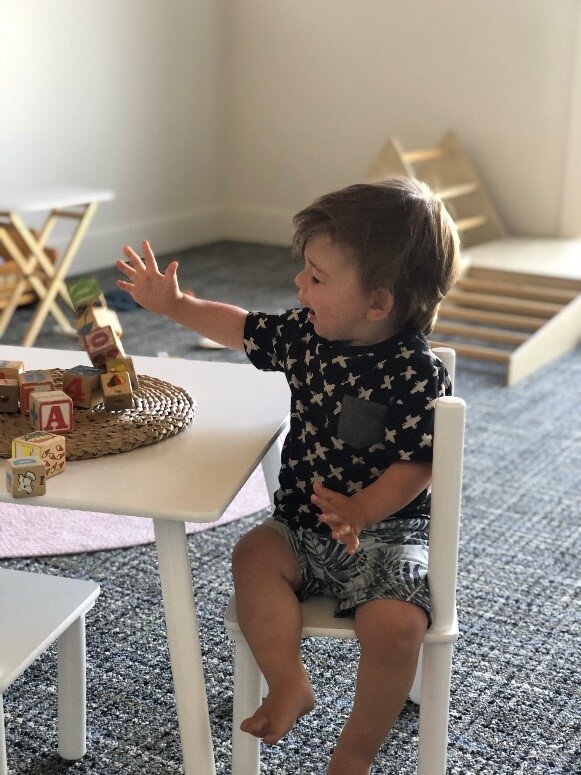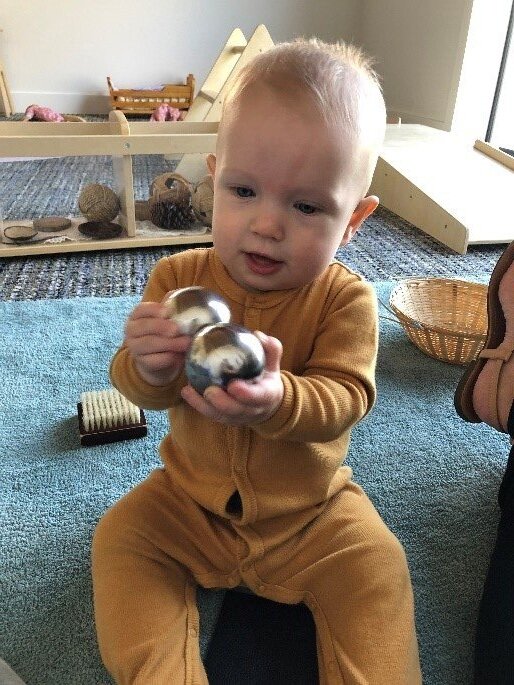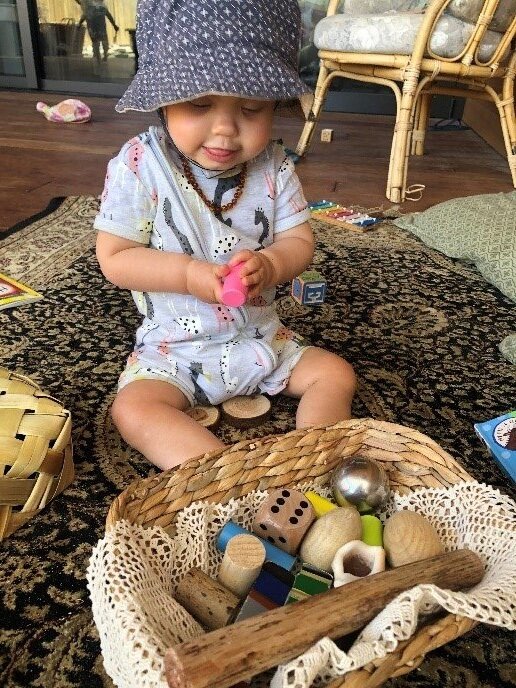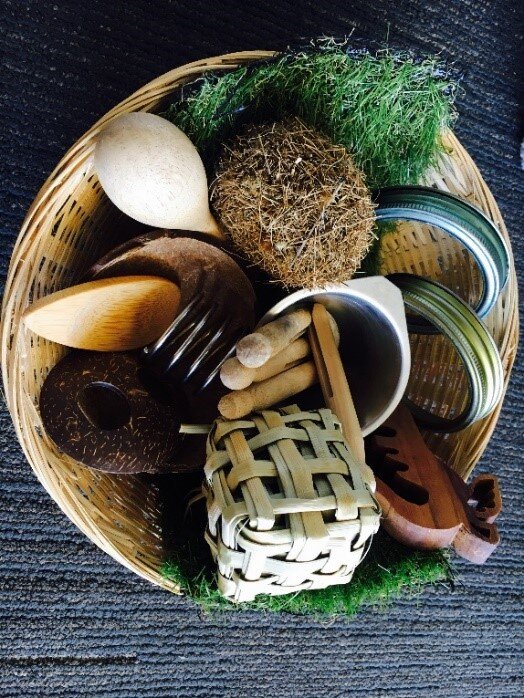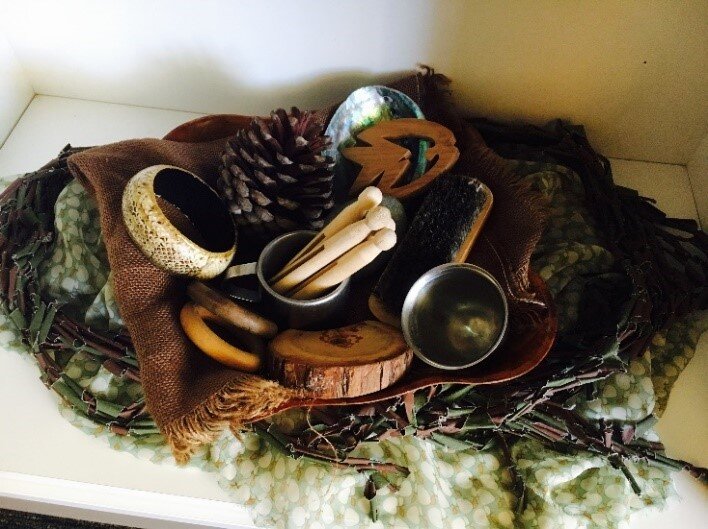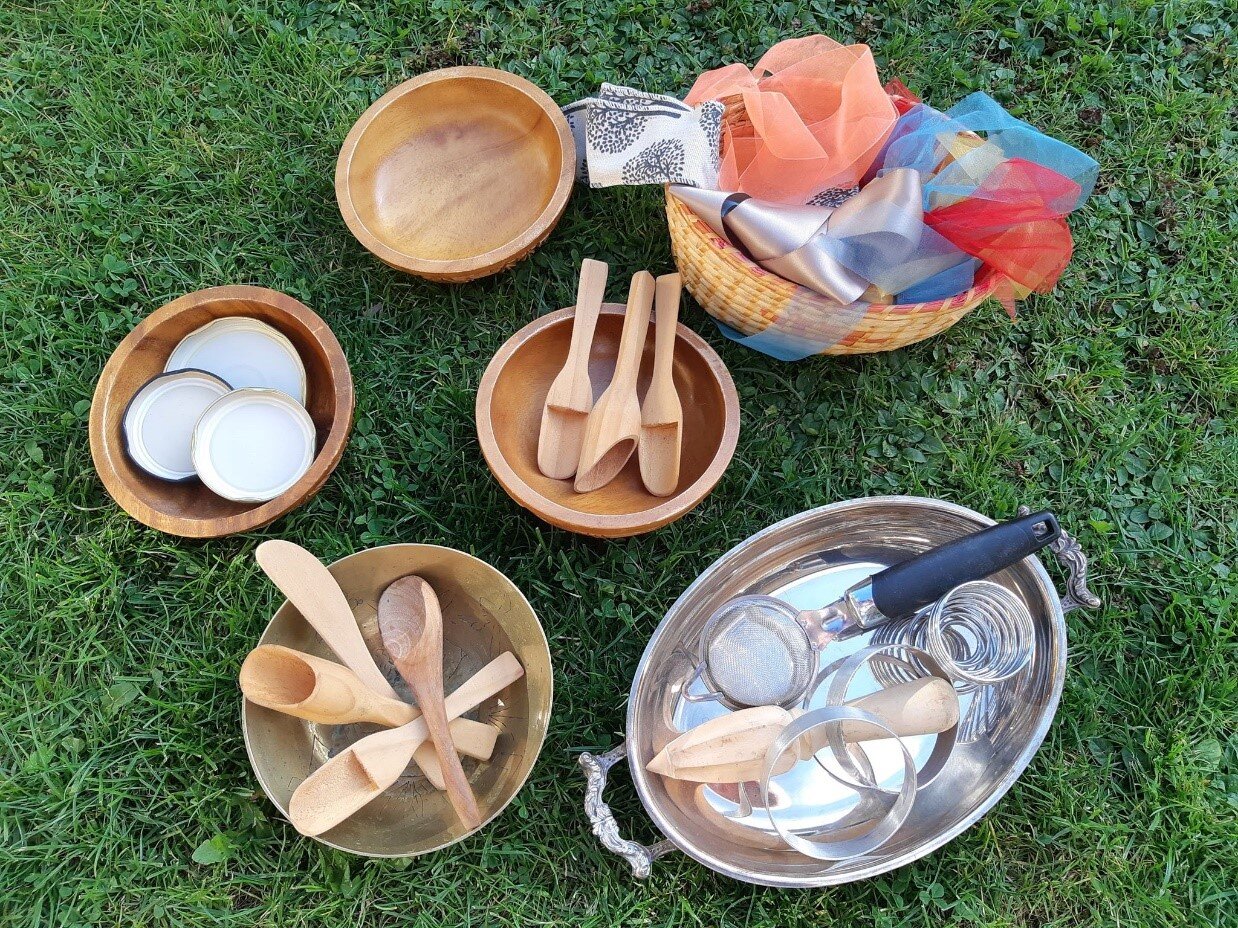Heuristic Play and Treasure Baskets – Marianne Beer
Visiting The Nest at any Gems and you will see Heuristic Play and Treasure Baskets either in use or set up ready to be explored. This type of play is present for the majority of our day in The Nest and I wanted to share with you some ideas as to how you can offer opportunities for this at home for your child.
Heuristic play is about playing with real-life, everyday objects and providing children with an opportunity for open-ended discovery.
Even in this age of technology there are plenty of fun things that you can find around your house that children can use to explore and experience different textures and sounds.
What is Heuristic Play?
Heuristic [Hyoo-ris-tic, or, often yoo-] Adjective
a: serving to indicate or point out; stimulating interest as a means of further investigation.
b: encouraging a person to learn, discover, understand, or solve problems on his or her own, as by experimenting, evaluating possible answers or solutions, or by trial and error - an heuristic teaching method.
c. of, pertaining to, or based on experimentation, evaluation, or trial and error methods.
The word ‘heuristic’ comes from the word ‘eurisko’ which means to learn, discover or reach an understanding of something. The phrase ‘heuristic play’ was a term coined by child psychologist Elinor Goldschmeid in the 1980’s to describe the activity of babies and children as they play with and explore the properties of objects from the real world.
Looking at the definitions above, the ideas and opportunities for heuristic play both in centre and at home are endless. The things we take for granted and barely give a second thought to in our day can be the most fascinating learning opportunities for your child.
Imagine sitting on the kitchen floor, surrounded by cooking paraphernalia (think pots, pans, wooden spoons, spatulas, metal whisks etc.) and discovering that you can make music when you bang two of the objects together. Give your child this opportunity and watch them come alive J
How many times have you been doing a household chore when your toddler has wanted to ‘help’ you? Things like using the dustpan and brush to sweep scraps from the floor then transfer it to the rubbish bin. The next time you find yourself in this situation, stop, then let them help. Allow them the opportunity to make a new discovery about how things work in the world around them.
When children are involved in heuristic play, they are using familiar objects in different ways. It is the process of exploring the different ways to use the objects that is important in the play. Children are progressing from the question ‘what is this object like?’ to ‘what else can I do with this?’
Imagine sitting with a pile of wooden blocks around you on the floor, picking two up and discovering that when you knock them together they make a noise; or working out that the blocks can sit on top of one another and if you repeat that pattern you can build a tower and even better, knock it over! Just imagine your child’s sense of accomplishment and pride in themselves in that moment.
For babies and toddlers, Goldschmeid’s approach to heuristic play revolves around them using their senses and exploring a treasure basket filled with real-world objects made from any material (apart from plastic) that comes from nature and around the house. This period of lockdown where we are all taking more walks in nature is the perfect opportunity to collect some materials for your own treasure basket. Things like autumn leaves, driftwood, river stones and pinecones all create an opportunity to explore and discover something in a new way.
It is through handling and exploring these objects that babies and toddlers begin to make their own choices and decisions and start to gain an understanding of the world around them.
What is a treasure basket?
A treasure basket is a carefully chosen basket made of natural materials, filled with a mixture of purchased and everyday household objects. The objects need to be safe, washable and offer children a variety of textures, sizes, colours and shapes. They can be made of paper, shell, metal, wood… any natural material that offers a rich sensory experience.
In The Nest, we have a collection of loose parts and heuristic play items that we create treasure baskets with. One of the most important things we do is ensure that the resources we put in the baskets are rotated regularly to allow the children maximum exposure to new and interesting objects and textures.
The baskets themselves have to be selected with the age and developmental stage of your child in mind - low sides for babies to reach into or even on a tray, or something a bit higher for those older children who can sit or stand themselves up to reach inside. It is also important to take the size of objects into consideration as everything will be mouthed and therefore may pose a risk of choking if items are too small.
It is also important to remember to take the basket away when the child has shown they have had enough for the day. This will prevent over exposure to the objects and lack of interest. Bring the basket out once a day and maybe rotate out a few objects to keep it interesting and allow for new discoveries to be made. “I know this a wooden spoon, now what else can I do with it? Does it fit in here? What happens if I bang it on this metal tin?”
Treasure baskets are especially empowering when you give children of this age extra, uncluttered space, allowing for opportunities to experiment with transporting (What, where and how will they take it?), cause and effect (what happens if I…?), posting (does this fit here?) and enveloping (can I cover this up with that?). They’ll start to problem solve, look at how objects fit together, test weights, textures and connections and use concentration and communication skills to find out more. It puts them into a rare leadership role where they can take ownership of their own learning and discovery.
When you’ve created your basket, set it in a space that is free of clutter or other toys. This will take away the overwhelming feelings for the child of ‘what should I play with first’ and allow them to focus solely on the treasure basket in front of them.
Your role now as the parent is to sit back and let your child play. Let your child imagine and explore as they learn strategies for thinking and reasoning through discovering the different properties of the objects as they touch, feel and manipulate them.
Why is heuristic play important for your child?
“Toys that do less, actually teach more.”
There are endless reasons as to why Heuristic Play is important for your child. I have captured a few of the main ideas below.
o Stimulates creativity and imagination - With heuristic play, open-ended play opportunities allow children to explore, learn and develop in a completely natural way.
o Supports gross motor skills and brain development in infants and toddlers - Infants and toddlers, in particular, require a variety of sensory exploration to support their cognitive growth and development. With heuristic play, they are able to do this on a much wider scale than with toys that are more one dimensional in purpose.
o Stimulates multiple senses and critical thinking – unlike pushing a button on a book that makes a sound, with heuristic play, children can make sounds from banging different objects together or knocking them against another surface. This then leads them to figure out the context for themselves – why did that make this sound? What would happen if I banged this item with a different item? All of these questions only come about by exploring and they are far more valuable later in life when our children need to develop certain skills such as innovation and critical thinking.
o Promotes early mathematical conceptual learning - When a child is exposed to a variety of items that range in size, shape, weight and texture, the time they spend exploring only aids their mathematical conceptual learning. This doesn’t tend to happen with typical toys as the need to explore is lessened when they know what the toy is meant to do.
o Children gain an understanding of the world around them - The mantra that “toys that do less, actually do more” is very relevant to heuristic play. It means that basic, everyday objects that we consider boring (or not toys) actually offer a world of possibilities to learn for our children. While they learn to play they also start to gain an understanding of the world around them, and more importantly, especially with children today, they learn that they don’t need much to self-entertain. It is through handling and exploring these objects that babies and toddlers begin to make their own choices and decisions and start to develop as people.
How can you implement heuristic play at home during lockdown?
We provide opportunities for this play at Gems by collecting a range of resources that can be found around the home, in the garden, things you might stumble across on a nature walk. Anything goes as long as it’s natural – no plastic allowed! Think metal, wooden, cane, cork, stone, marble, textiles and paper.
It is easy to collect materials around your home to provide a heuristic play opportunity for your child. I’ve added a list below of objects you might find in your home that you can collate in a basket or box for your child:
· Brushes/combs
· Loofa
· Pine cones
· Rings
· Curlers
· Old Door knobs
· Bangles
· Small whisks
· Textured balls
· Wooden pegs
· Cardboard cylinders
· Ribbons
· Large corks
· Jars
· Pom poms
· Lids
· Wooden
· Curtain rings
· Egg cups
· Baking paper
To mix things up you could sort and combine your treasures in interesting ways and be prepared to rearrange on different days: by colour, by shape, form or perhaps use. Include items that encourage learners to fill, empty, stack, flip and sort. (Keep in mind there is no right way to use the objects, this is an open-ended experience with no sense of completion or testing of achievement applied). Use fabrics to line your baskets like scarves or even a nice textured tea towel.
I hope you have fun creating some opportunities for Heuristic Play at home with your children. I’d love to see what you come up with or hear some stories of how your children engaged with the baskets you created. I know that I can speak on behalf of the entire team in The Nest at Gems when I say we miss seeing you all every day and being able to create learning opportunities like this for the children. Share your stories on Educa or in the comments section below this post.
Marianne


